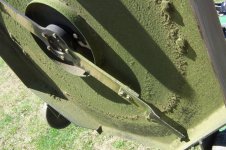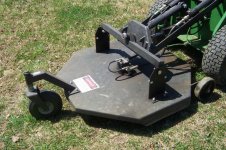A metallurgist posted this on my Simplicity site about hardening (i.e. tempering) mower blades:
Being a metalurgist for over 15 years I can say with out reservation that bringing any type of metal to it's temper colors, or austenetic temprature (which is near 1200 degrees) will allow the metal to be conditioned to a variety of final temper conditons. First, after reaching temper, or the point in which a magnet will no longer stick to the ferrous metal, you can case harden, anneal, normalize or shock harden. Case hardening happens when temper is reached and the metal is placed in near pure carbon then oil quenched. This is called carburizing. Annealing is achieved by heating to austenetic (temper) temprature then SLOWLY cooling. Normalizing is achieved through heating to austenitic temp and then allowing to air cool. The faster the air cooling takes place determines the brinell hardness. This is a key factor in the ultimate result of your final tempering process. After normalizing you can then manipulate the ferous metal by heating it up to between 1050 and 1300 degrees. Taking the metal to a "cherry red" state allows the Martinsite and Pearlite molecules to "relax" into one flowing form as opposed to being left in it's "as formed" stressed state. Bottom line.......when you sharpen, do so at the correct angle as set forth by the manufacturer. Then use a torch and a magnet on the blade untill the magnet falls off on it's own. Then quench in heated water or used motor oil. (Do this out side in a metal pail and use tongs)Once the blade is cool, lightly grind or file the cutting edge so you can see bare metal. Then heat the edges untill they just start to blue and quench in water right away. This will normalize the metal and then temper it so that it will hold an edge longer. Tempering is a good thing, not a bad thing. If you really want a strong edge you can crush charcoal in to a powder, heat to the point where a magnet falls off the blade and then imerse the metal into the charcoal for a few seconds and then oil quench. This will effectively "case harden" the bear edge of the blade while leaving the subcutaneous metal more ductile and flexible for reducing shear or breakage.
An example.....take a hack saw blade, heat it up to the point where a magnet falls off then SLOWLY cool the blade. You'll be able to tie the hack saw blade in a knot before it breaks. Take a hack saw blade from a pack of new blades, put it in a vice and whack it near the vice with a hammer. It'll break in half. You can take ANY ferrous(magnetic) metal and make it do what you want it to with the right process of heating, cooling then re-heating. Just quenching a red hot blade will cause deep chipping of the edge of the blade. If you treat the red hot edge of the blade correctly you will have a lasting edge that can last two seasons easily. And then re-sharpening wont mean having to cut a lot off the blade to gain a good edge.



